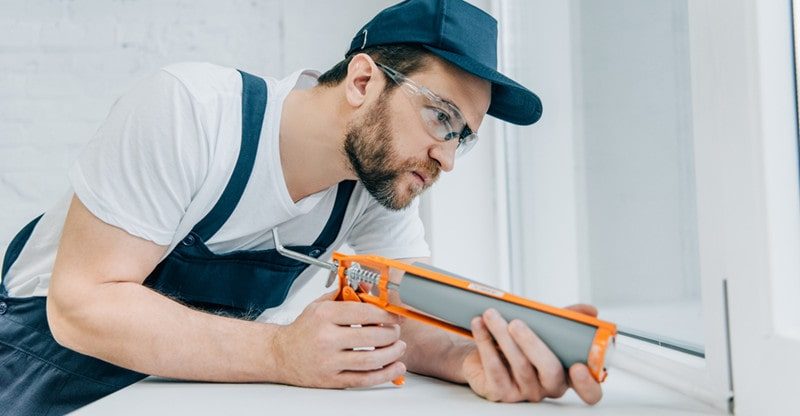A DIY Guide to Different Kinds of Sealers
Sealers do what they say on the tin. They seal things.
If you take a look around your home, you’ll see lots of different kinds of sealers. Some sealers are designed to prevent air leaks, others are designed to seal against water. Some sealers are different colors while others are made from different materials.
For DIYers, understanding which sealant to use and where to use it can be a bit tricky. There are just so many options on the table.
Luckily, we’re here to make things easier.
This guide will talk you through the different kinds of sealers available and discuss their uses and applications.
Acoustic Sealers
Designed to prevent soundwaves from escaping, this sealer is used to soundproof buildings or rooms.
The acoustic sealer is fairly soft and flexible which allows it to mitigate and dampen soundwaves effectively. It also seals against moisture and vapor despite not being specifically designed for this purpose.
Acrylic Sealant
This is a common sealant used to finish joints and joins around the house. It is strong, paintable, odorless and easy to apply.
Acrylic sealant is water-resistant and insulating which is why it’s used on skirting boards and flooring.
Adhesive Sealers
In general, sealers should not be used as adhesives. This is because they are not designed to hold surfaces together.
Of course, as the name suggests, adhesive sealers are the exception to this rule.
It’s important to remember that adhesive sealers are not as strong as straight adhesives. This is because the sealer material weakens the adhesive bonds.
However, these sealers can be used on lighter things like skirting boards and windows. These things require both sealing and adhesive but don’t rely solely on the adhesive sealer for staying power.
Elastic Sealers
This sealer contains elastomeric bitumen which makes it flexible even when it has dried hard.
Used as a filler, elastic sealer can be applied to cracks, holes, and joints. When set, the sealer creates a waterproof seal that expands to fill the desired gap.
Floor Sealer
Unlike most of the other sealers on this list, floor sealer is not a thick paste applied with a caulking gun or tube.
A floor sealer is typically a thin transparent liquid that is applied to your floors. It cures and creates a waterproof barrier over your flooring. It also helps prevent bacterial growth and damage to your floors.
Not all floors require sealing and not all floor sealers are suitable for all floors. Always check labels and manufacturer’s guidelines before applying.
Foam Sealer
Foam sealer is sometimes known as expanding foam sealer. As you may have guessed, foam sealer expands as it sets. The rate of expansion varies from brand to brand but a 30% increase is a good average.
When set, foam sealer prevents air and soundwaves from passing through making this stuff ideal for use as insulation and to fill gaps and holes.
Latex Sealant
This is the sealer you’ll find yourself using the most as a DIYer. Latex sealer is easy to apply, easy to paint, has low odors, high UV protection, and is one of the cheapest sealers.
As a water-resistant, durable and flexible product, this sealant is ideal for use in many places around the house. It can be used around sinks, skirting boards, windows, tiles, and pretty much anywhere else you want.
Patio Sealer
Patio sealer is similar to floor sealer in that it’s a liquid solution applied to the ground. However, this stuff is generally stronger than floor sealer because it has to cope with harsher conditions.
Sometimes called brick paver sealer or paving sealer, it prevents bacterial growth and stops moisture from seeping into your outdoor surfaces.
Polysulfide Sealer
This stuff is typically used inside pools, fountains, chemical storage tanks, and similar. Essentially, you’d use a polysulfide sealer if the area is going to be submerged in water or chemicals.
This stuff is tough. It can survive underwater without degrading. It is exceptionally resistant to most chemicals and fuels. It’s also just unbelievably strong.
Mostly, polysulfide sealer is used by specialists or professionals.
Polyurethane Sealer
Polyurethane sealant is used in places where high strength is a priority. It is abrasion-resistant and shock absorbing meaning it is ideal for traffic-heavy areas like floors and even roads.
This sealer is waterproof and can adhere to pretty much any solid surface. The only downside is that it can be quite tricky to apply. For that reason, it’s normally used by professionals.
Rubber Sealant
Usually used for caravans, RVs and cars when you want to create a semi-permanent seal, rubber sealant remains gum-like in consistency.
This stuff is mostly used by professionals and specialists so you’re unlikely to come across it as a DIYer.
Silicone Sealant
Silicone sealants are workhorses. They are completely waterproof, UV resistant, flexible, and durable. This sealant can be used at home around baths, sinks, and windows but it also has industrial applications.
The downside to silicone sealer is the price and the fact that it has a fairly noxious odor. Another downside is that silicone sealant can’t be painted.
Urethane Sealant
This sealant can be painted which makes it useful around the house. It is water-resistant and forms an effective barrier against air.
It is tear-resistant and hard-wearing but it does degrade in UV light. This is also really difficult to wash off your hands and clothes.



